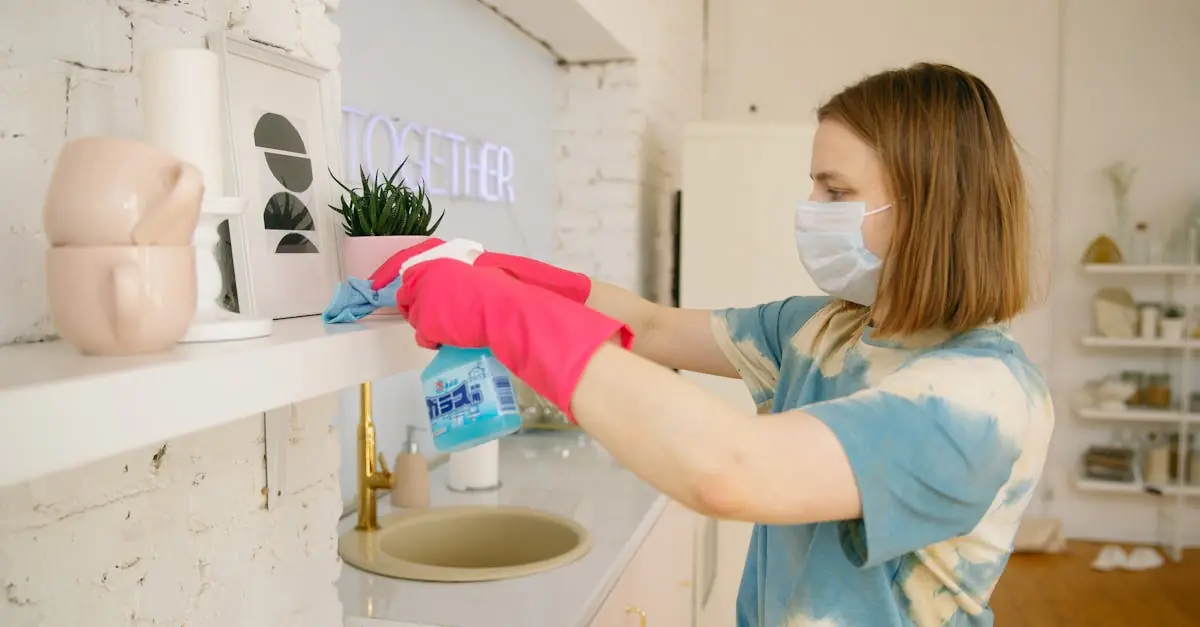Table of Contents
ToggleDust may seem harmless, but it’s the sneaky ninja of household grime, lurking in every corner and on every surface. If left unchecked, it can turn a sparkling home into a sneeze-inducing disaster zone. But fear not! Mastering the art of dusting can transform your space from a dusty dungeon into a pristine palace.
Understanding Dusting Best Practices
Effective dusting practices play a crucial role in maintaining indoor air quality and overall hygiene. Proper techniques prevent dust build-up, enhancing the living environment significantly.
Importance of Dusting
Dusting protects health by reducing allergens like pet dander, pollen, and dust mites. It contributes to clearer air, making it vital for individuals with respiratory issues. Regular dusting also preserves furniture and surfaces, preventing long-term damage and wear. Maintaining a dust-free environment creates a more pleasant atmosphere, promoting overall well-being.
Common Dusting Techniques
Using microfiber cloths captures dust better than traditional dusters, making microfiber an effective choice. Employing a top-to-bottom approach ensures dust falls down, preventing recontamination of already cleaned areas. Combining furniture polish with dusting can enhance shine while trapping particles. Vacuuming with a HEPA filter helps eliminate dust particles from carpets before dust can settle elsewhere. Making dusting a routine, preferably weekly, maintains a consistently clean space.
Essential Tools for Effective Dusting
To achieve effective dusting, using the right tools makes a significant difference. Proper selections optimize results and enhance dust removal efficiency.
Types of Dusting Cloths and Tools
Microfiber cloths capture dust effectively due to their unique fibers. These cloths can hold more dust particles compared to traditional materials. Additionally, feather dusters are handy for reaching intricate areas, like ceiling fans and light fixtures. They effectively remove dust without redistributing it into the air. Other tools, such as electrostatic dusters, attract dust particles through static electricity, making them particularly effective on surfaces that collect dust quickly. Finally, using a vacuum with a HEPA filter helps in eliminating fine dust and allergens from carpets and upholstery.
Choosing the Right Cleaning Solution
Selecting the appropriate cleaning solution can enhance dusting efforts significantly. Eco-friendly options exist, including vinegar and water mixtures that provide effective cleaning without harsh chemicals. Also, specialized dusting sprays may contain ingredients that help capture and lock in dust. These products often improve efficiency, reducing the effort required during dusting. Always remember to check for compatibility with surfaces to prevent damage. It’s crucial to choose the right solution that aligns with personal cleaning preferences while being effective in dust removal.
Methodologies in Dusting
Effective methodologies in dusting enhance cleanliness and air quality in living spaces. Adopting tailored strategies for different rooms contributes to better dust management.
Room-by-Room Dusting Strategies
Employ distinct dusting techniques for each area. Living rooms benefit from microfiber cloths to capture dust on electronics and furniture surfaces. Bedrooms require attention to bedding and hard-to-reach areas like ceiling fans. In kitchens, wiping down appliances and countertops helps minimize dust accumulation. Bathrooms merit regular dusting of shelves, light fixtures, and vents to eliminate moisture-related dust. Closed spaces like closets need periodic checks to remove dust from clothing and shoes. This targeted approach ensures thorough cleaning throughout the home.
Frequency of Dusting
Consistency plays a vital role in dust control. Regular dusting at least once a week significantly reduces dust buildup and allergens. High-traffic areas may require more frequent attention to maintain cleanliness. For individuals with allergies or respiratory issues, a bi-weekly schedule often proves beneficial. Adapting dusting frequency to season changes can further enhance indoor air quality. For example, additional dusting during spring helps combat pollen. Routine monitoring of dust levels ensures a consistently clean environment.
Health Benefits of Dusting Regularly
Dusting regularly significantly contributes to health and well-being. It plays a crucial role in minimizing allergens and pollutants present in indoor spaces, fostering cleaner air.
Reducing Allergens and Pollutants
Reducing allergens and pollutants promotes better respiratory health. Dust contains particles such as pet dander, pollen, and dust mites that can trigger allergies and asthma. Employing effective dusting techniques lowers these contaminants, especially in homes where pets reside or in areas with high pollen counts. Cleaning surfaces with microfiber cloths captures dust more efficiently, ensuring harmful irritants do not circulate in the air people breathe. Maintaining such cleanliness is vital for individuals with pre-existing respiratory conditions, as fresh air helps prevent exacerbation of symptoms.
Creating a Healthier Living Environment
Creating a healthier living environment starts with regular dusting. Consistent cleaning practices enhance overall air quality and reduce the risk of dust-related illnesses. A clean home minimizes surface dust accumulation that can harbor bacteria and allergens. Maintaining furniture and surfaces through dusting preserves their condition and supports a visually appealing atmosphere that promotes relaxation. Overall, an organized and dust-free space contributes to mental clarity, making daily activities more enjoyable and less stressful.
Effective dusting practices are essential for maintaining a clean and healthy home. By implementing the right techniques and tools, individuals can significantly reduce allergens and improve indoor air quality. Regular dusting not only protects furniture but also creates a more pleasant living environment.
Adopting a consistent dusting routine tailored to specific areas ensures thorough cleaning and minimizes dust buildup. This proactive approach fosters better respiratory health and enhances overall well-being. With these best practices in mind, anyone can transform their space into a spotless sanctuary, promoting a healthier lifestyle for all occupants.





